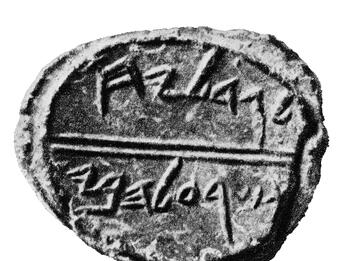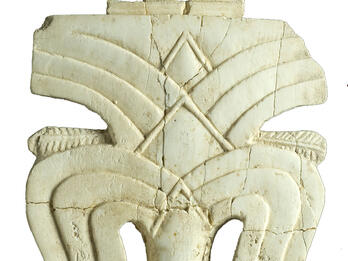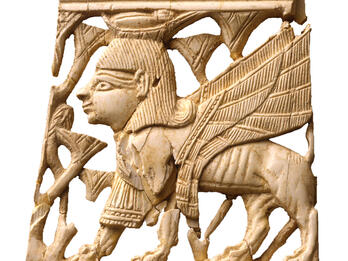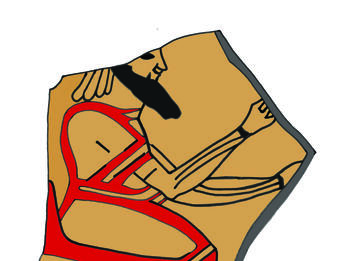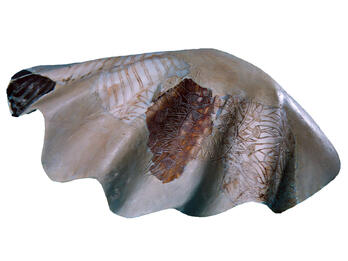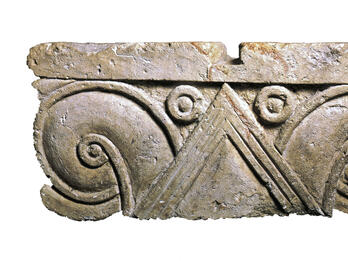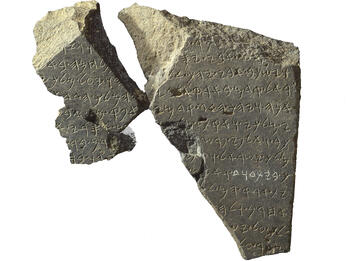Showing Results 1 - 10 of 25
Public Access
Image
Bulla of Gedalyahu, Lachish. The text (bulla) reads: “Belonging to Gedalyahu, the Steward of the Palace.” This may be Gedaliah ben Ahikam, who was appointed governor of Judah by Nebuchadnezzar after…
Places:
Lachish, Land of Israel (Tel Lakhish, Israel)
Date:
Late 6th Century BCE
Subjects:
Restricted
Image
Palm imagery is a common motif in decorative architectural elements like window balustrades. Each of the four columns in this partial restoration from the biblical period is six inches in diameter and…
Places:
Ramat Rahel, Land of Israel (Ramat Rahel, Israel)
Date:
Iron Age II, Late 8th–Early 7th Century BCE
Subjects:
Categories:
Restricted
Image
Many of the seal impressions, with the inscription lamelekh “(Belonging, or pertaining) to the king,” followed by the name of a city, feature a two-winged figure, probably a winged sun disk…
Places:
Tel ‘Erani, Land of Israel (Tel ‘Erani, Israel)
Date:
Iron Age IIB–IIC, Late 8th–7th Century BCE
Subjects:
Categories:
Restricted
Image
Some lamelekh impressions, like this one from Lachish, have a four-winged scarab beetle as their central image. The scarab beetle was an important mythological symbol in Egypt, associated with Khepri…
Places:
Lachish, Land of Israel (Tel Lakhish, Israel)
Date:
Iron Age IIB–IIC, Late 8th–7th Century BCE
Subjects:
Categories:
Restricted
Image
This and the next several ivories come from the approximately twelve thousand ivory pieces and fragments that were found in the royal compound in the city of Samaria, capital of the Northern Kingdom…
Places:
Samaria, Land of Israel (Samaria, Israel)
Date:
Iron Age IIA–IIB, 9th–8th Century BCE
Subjects:
Categories:
Restricted
Image
Sphinxes are among the most ubiquitous images on Iron Age Levantine ivories. The sphinx combines the features of several animals; it has the head of a human, the wings of an eagle, and the body of a…
Places:
Samaria, Land of Israel (Samaria, Israel)
Date:
Iron Age IIA–IIB, 9th–8th Century BCE
Subjects:
Categories:
Restricted
Image
This is a modern artist’s illustration of a painting of a seated male in profile, perhaps an enthroned dignitary. The painting was made on a potsherd from Ramat Rahel. It measures around 5 × 3 inches…
Places:
Ramat Rahel, Land of Israel (Ramat Rahel, Israel)
Date:
Iron Age II, Late 8th–Early 7th Century BCE
Subjects:
Categories:
Restricted
Image
Engraved tridacna (clam) shells like this one from Arad seem to have been used as cosmetic containers in the Near East and Mediterranean worlds in the late seventh and early sixth centuries BCE. This…
Places:
Arad, Land of Israel (Tel ‘Arad, Israel)
Date:
Iron Age IIC, Second Half of 7th–Early 6th Century BCE
Subjects:
Categories:
Restricted
Image
The palm and the palmette are common iconographic elements in ancient Near Eastern art, appearing, for example, in ivory decoration (see Ivory and Bone Carvings and Engraved Seashells) and in Assyrian…
Places:
Ramat Rahel, Land of Israel (Ramat Rahel, Israel)
Date:
Iron Age II, Late 8th–Early 7th Century BCE
Subjects:
Categories:
Restricted
Text
Image
[ . . . . . . . . ] and cut (a treaty) [
[ . . . e]l my father went up [against him when] he was fighting in Abe[l?]
And my father lay down, he went to his [ancestors (or: eternal place)]. And the…
Places:
Dan, Land of Israel (Tel Dan, Israel)
Date:
Late 9th Century BCE


